The ASTM A194 material grades specifications and dimensional charts for hexagonal steel nuts for stud bolts charts
HEX NUTS & WASHERS FOR STUD BOLTS
WHAT ARE NUTS & WASHERS FOR STUD BOLTS
Nuts and washers play crucial roles in the effectiveness and longevity of stud bolt connections in various applications, from general construction to high-pressure and high-temperature environments like those found in the petrochemical industry.
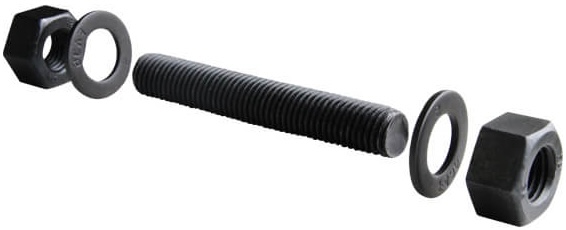
Here’s an overview of their functions and types:
Nuts for Stud Bolts
Nuts are paired with stud bolts to apply clamping force across the connected parts. They engage with the threaded ends of stud bolts, allowing for the adjustment of tension and holding components securely together. The most common types of nuts used with stud bolts include:
- Hex Nuts: The most common type, offering a good balance of size, shape, and ease of use. They are typically used in pairs, with one nut on each end of the stud bolt.
- Heavy Hex Nuts: Larger and thicker than standard hex nuts, providing more robust engagement with the stud bolt and distributing the load over a larger area, which is beneficial in high-pressure applications.
- Lock Nuts: Designed to prevent loosening under vibration and torque. They can have various features for locking, including nylon inserts (nyloc nuts) or distorted threads.
Washers for Stud Bolts
Washers distribute the load of a nut or bolt head over a larger area, which can help prevent the bolt head or nut from digging into the surfaces of the connected parts. They also protect the surface of the assembled parts from damage during the tightening process. Moreover, washers can help to maintain preload and ensure the reliability of the bolted connection under thermal expansion and contraction. Common types of washers include:
- Flat Washers: The most basic type, used to distribute the load over a broader area and to prevent damage to the surface material.
- Spring Washers (Belleville Washers): Conical-shaped washers that provide a spring force between the head of the bolt and the substrate, helping to maintain the bolt’s tension in applications subject to vibrations.
- Lock Washers: Intended to prevent the nut from loosening. They can have a split (helical spring washer) or toothed design to grip the nut and the mounting surface.
Application Considerations
The choice of nuts and washers for stud bolts depends on several factors, including the mechanical requirements of the connection (e.g., load-bearing capacity), environmental conditions (e.g., temperature, presence of corrosive elements), and specific application requirements (e.g., vibration resistance). Materials commonly used for nuts and washers include carbon steel, stainless steel, and alloys designed for specific environmental resistances.
In high-stress or critical applications, such as flanged connections in the oil and gas industry, the correct selection and installation of nuts, washers, and stud bolts are vital for ensuring the integrity and safety of the connection. Proper maintenance and regular inspection are also crucial to prevent failure and extend the service life of these connections.
DIMENSIONAL CHARTS
The chart below shows the hex nuts’ width and thicknesses by diameter:
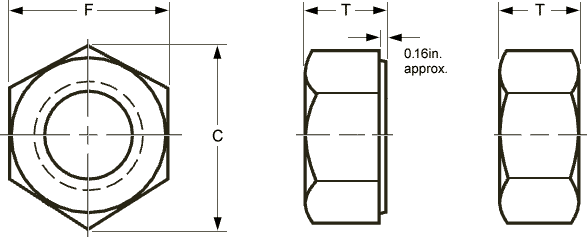
| HEAVY HEX NUTS DIAMETER (inches) | Width Across Flats | Width Across Corners | |||
| F | C | ||||
| Basic | Max | Min | Max | Min | |
| 1/2 | 7/8 | 0.875 | 0.850 | 1.010 | 0.969 |
| 5/8 | 1.1/16 | 1.062 | 1.031 | 1.227 | 1.175 |
| 3/4 | 1.1/4 | 1.250 | 1.212 | 1.443 | 1.382 |
| 7/8 | 1.7/16 | 1.438 | 1.394 | 1.660 | 1.589 |
| 1 | 1.5/8 | 1.625 | 1.575 | 1.876 | 1.796 |
| 1⅛ | 1.13/16 | 1.812 | 1.756 | 2.093 | 2.002 |
| 1¼ | 2 | 2.000 | 1.938 | 2.309 | 2.209 |
| 1⅜ | 2.3/16 | 2.188 | 2.119 | 2.526 | 2.416 |
| 1½ | 2.3/8 | 2.375 | 2.300 | 2.742 | 2.622 |
| 1⅝ | 2.9/16 | 2.562 | 2.481 | 2.959 | 2.828 |
| 1¾ | 2.3/4 | 2.750 | 2.662 | 3.175 | 3.035 |
| 1⅞ | 2.15/16 | 2.938 | 2.844 | 3.392 | 3.242 |
| 2 | 3.1/8 | 3.125 | 3.025 | 3.608 | 3.449 |
| 2¼ | 3.1/2 | 3.500 | 3.388 | 4.041 | 3.862 |
| 2½ | 3.7/8 | 3.875 | 3.750 | 4.474 | 4.275 |
| 2¾ | 4.1/4 | 4.250 | 4.112 | 4.907 | 4.688 |
| 3 | 4.5/8 | 4.625 | 4.475 | 5.340 | 5.102 |
| 3¼ | 5 | 5.000 | 4.838 | 5.774 | 5.515 |
| 3½ | 5.3/8 | 5.375 | 5.200 | 6.207 | 5.928 |
| 3¾ | 5.3/4 | 5.750 | 5.562 | 6.640 | 6.341 |
| 4 | 6.1/8 | 6.125 | 5.925 | 7.073 | 6.755 |

| HEAVY HEX NUT DIAMETER (inches) | Hex Heavy Nut Thickness | ||
| Basic | Max | Min | |
| 1/2 | 31/64 | 0.504 | 0.464 |
| 5/8 | 39/64 | 0.631 | 0.587 |
| 3/4 | 47/64 | 0.758 | 0.710 |
| 7/8 | 55/64 | 0.885 | 0.833 |
| 1 | 63/64 | 1.012 | 0.956 |
| 1⅛ | 1.7/64 | 1.139 | 1.079 |
| 1¼ | 1.7/32 | 1.251 | 1.187 |
| 1⅜ | 1.11/32 | 1.378 | 1.310 |
| 1½ | 1.15/32 | 1.505 | 1.433 |
| 1⅝ | 1.19/32 | 1.632 | 1.556 |
| 1¾ | 1.23/32 | 1.759 | 1.679 |
| 1⅞ | 1.27/32 | 1.886 | 1.802 |
| 2 | 1.31/32 | 2.013 | 1.925 |
| 2¼ | 2.13/64 | 2.251 | 2.155 |
| 2½ | 2.29/64 | 2.505 | 2.401 |
| 2¾ | 2.45/64 | 2.759 | 2.647 |
| 3 | 2.61/64 | 3.013 | 2.893 |
| 3¼ | 3.3/16 | 3.252 | 3.124 |
| 3½ | 3.7/16 | 3.506 | 3.370 |
| 3¾ | 3.11/16 | 3.760 | 3.616 |
| 4 | 3.15/16 | 4.014 | 3.862 |
WEIGHTS
HEX NUTS WEIGHT IN LBS
Hex nuts weight in Lbs (pounds/ 100 pieces) by diameter:
| Heavy Hex Nuts Diameter | Finished Hex | Heavy Hex | Finished Jam | Heavy Hex Jam | Square | Heavy Square |
| 1/2″ | 3.75 | 6.54 | 2.62 | 4 | 5.78 | 7.87 |
| 5/8″ | 7.33 | 11.9 | 4.93 | 6.96 | 10.8 | 14.3 |
| 3/4″ | 11.9 | 19.3 | 7.7 | 11 | 15.4 | 23.5 |
| 7/8″ | 19 | 29.7 | 12 | 16.7 | 24.5 | 36.2 |
| 1″ | 28.3 | 42.5 | 17.6 | 23.5 | 36.3 | 51.5 |
| 1-1/8″ | 40.3 | 59.2 | 24.7 | 32.4 | 52.5 | 72.4 |
| 1-1/4″ | 54.3 | 78.6 | 36.1 | 45.8 | 70.6 | 95.5 |
| 1-3/8″ | 73 | 102 | 47.9 | 59.3 | 94.5 | 125 |
| 1-1/2″ | 94.3 | 131 | 60.9 | 74.8 | 122 | 161 |
| 1-5/8″ | 162 | 91.6 | ||||
| 1-3/4″ | 151 | 204 | 100 | 114 | ||
| 1-7/8″ | 241 | 134 | ||||
| 2″ | 224 | 299 | 140 | 165 | ||
| 2-1/4″ | 419 | 227 | ||||
| 2-1/2″ | 564 | 332 | ||||
| 2-3/4″ | 738 | 429 | ||||
| 3″ | 950 | 545 | ||||
| 3-1/4″ | 1194 | 651 | ||||
| 3-1/2″ | 1526 | 851 | ||||
| 3-3/4″ | 1812 | 1005 | ||||
| 4″ | 2180 | 1200 |
The weight of heavy hexagonal steel nuts for stud bolts in lbs / 100 units – ASME B18.2.2
HEX NUTS WEIGHT IN KILOGRAMS
Hex nuts weight in Kgs. (kg/100 pieces) by diameter:
| Heavy Hex Nuts Diameter | Finished Hex | Heavy Hex | Finished Jam | Heavy Hex Jam | Square | Heavy Square |
| 1/2″ | 1.70 | 2.97 | 1.19 | 1.81 | 2.62 | 3.57 |
| 5/8″ | 3.32 | 5.40 | 2.24 | 3.16 | 4.90 | 6.49 |
| 3/4″ | 5.40 | 8.75 | 3.49 | 4.99 | 6.98 | 10.66 |
| 7/8″ | 8.62 | 13.47 | 5.44 | 7.57 | 11.11 | 16.42 |
| 1″ | 12.83 | 19.27 | 7.98 | 10.66 | 16.46 | 23.36 |
| 1-1/8″ | 18.28 | 26.85 | 11.20 | 14.69 | 23.81 | 32.83 |
| 1-1/4″ | 24.63 | 35.65 | 16.37 | 20.77 | 32.02 | 43.31 |
| 1-3/8″ | 33.11 | 46.26 | 21.72 | 26.89 | 42.86 | 56.69 |
| 1-1/2″ | 42.77 | 59.41 | 27.62 | 33.92 | 55.33 | 73.01 |
| 1-5/8″ | 0.00 | 73.47 | 0.00 | 41.54 | ||
| 1-3/4″ | 68.48 | 92.51 | 45.35 | 51.70 | ||
| 1-7/8″ | 0.00 | 109.29 | 0.00 | 60.77 | 0.00 | |
| 2″ | 101.58 | 135.60 | 63.49 | 74.83 | 0.00 | |
| 2-1/4″ | 190.02 | 0.00 | 102.94 | 0.00 | ||
| 2-1/2″ | 255.77 | 0.00 | 150.56 | 0.00 | ||
| 2-3/4″ | 334.68 | 0.00 | 194.55 | 0.00 | ||
| 3″ | 430.83 | 0.00 | 247.16 | 0.00 | ||
| 3-1/4″ | 541.48 | 0.00 | 295.23 | 0.00 | ||
| 3-1/2″ | 692.04 | 0.00 | 385.93 | 0.00 | ||
| 3-3/4″ | 821.74 | 0.00 | 455.77 | 0.00 | ||
| 4″ | 988.63 | 0.00 | 544.20 |
STUD BOLT WEIGHT IN KGS (STUD+ 2 HEX NUTS)
Complete stud bolt assembly weight in Kgs. (kg/100 pieces) by metric size:
| Heavy Hex Nuts Diameter (Metric) | Bolt Weight (kg) | Nut Weight (kg) | Total Weight (kg) |
| M12 x 35 | 0.049 | 0.013 | 0.062 |
| M12 x 40 | 0.053 | 0.013 | 0.066 |
| M12 x 45 | 0.058 | 0.013 | 0.071 |
| M12 x 50 | 0.062 | 0.013 | 0.075 |
| M12 x 55 | 0.067 | 0.013 | 0.080 |
| M12 x 60 | 0.071 | 0.013 | 0.084 |
| M12 x 65 | 0.072 | 0.013 | 0.085 |
| M12 x 70 | 0.080 | 0.013 | 0.093 |
| M12 x 75 | 0.085 | 0.013 | 0.098 |
| M12 x 80 | 0.089 | 0.013 | 0.102 |
| M12 x 85 | 0.094 | 0.013 | 0.107 |
| M12 x 90 | 0.098 | 0.013 | 0.111 |
| M12 x 95 | 0.103 | 0.013 | 0.116 |
| M12 x 100 | 0.107 | 0.013 | 0.120 |
| M12 x 105 | 0.111 | 0.013 | 0.124 |
| M12 x 110 | 0.116 | 0.013 | 0.129 |
| M 16X35 | 0.087 | 0.032 | 0.119 |
| M 16X40 | 0.094 | 0.032 | 0.126 |
| M 16X45 | 0.102 | 0.032 | 0.134 |
| M 16X50 | 0.110 | 0.032 | 0.142 |
| M 16X55 | 0.118 | 0.032 | 0.150 |
| M 16X60 | 0.126 | 0.032 | 0.158 |
| M 16X65 | 0.132 | 0.032 | 0.164 |
| M 16X70 | 0.141 | 0.032 | 0.173 |
| M 16X75 | 0.148 | 0.032 | 0.180 |
| M 16X80 | 0.153 | 0.032 | 0.185 |
| M 16X85 | 0.161 | 0.032 | 0.193 |
| M 16X90 | 0.167 | 0.032 | 0.199 |
| M 16X95 | 0.177 | 0.032 | 0.209 |
| M 16X100 | 0.186 | 0.032 | 0.218 |
| M 16X105 | 0.195 | 0.032 | 0.227 |
| M 16X110 | 0.203 | 0.032 | 0.235 |
| M 16X115 | 0.211 | 0.032 | 0.243 |
| M 16X120 | 0.220 | 0.032 | 0.252 |
| M 16X125 | 0.228 | 0.032 | 0.260 |
| M 16X130 | 0.235 | 0.032 | 0.267 |
| M 16X135 | 0.243 | 0.032 | 0.275 |
| M 16X140 | 0.251 | 0.032 | 0.283 |
| M 16X145 | 0.259 | 0.032 | 0.291 |
| M 16X150 | 0.267 | 0.032 | 0.299 |
| M 16X155 | 0.270 | 0.032 | 0.302 |
| M 16X160 | 0.278 | 0.032 | 0.310 |
| M 16X165 | 0.286 | 0.032 | 0.318 |
| M 16X170 | 0.294 | 0.032 | 0.326 |
| M 16X175 | 0.302 | 0.032 | 0.334 |
| M 16X180 | 0.310 | 0.032 | 0.342 |
| M 16X185 | 0.318 | 0.032 | 0.350 |
| M 16X190 | 0.326 | 0.032 | 0.358 |
| M 16X195 | 0.334 | 0.032 | 0.366 |
| M 16X200 | 0.342 | 0.032 | 0.374 |
| M 20X45 | 0.173 | 0.061 | 0.234 |
| M 20X50 | 0.186 | 0.061 | 0.247 |
| M 20X55 | 0.198 | 0.061 | 0.259 |
| M 20X60 | 0.211 | 0.061 | 0.272 |
| M 20X65 | 0.223 | 0.061 | 0.284 |
| M 20X70 | 0.235 | 0.061 | 0.296 |
| M 20X75 | 0.248 | 0.061 | 0.309 |
| M 20X80 | 0.260 | 0.061 | 0.321 |
| M 20X85 | 0.273 | 0.061 | 0.334 |
| M 20X90 | 0.285 | 0.061 | 0.346 |
| M 20X95 | 0.297 | 0.061 | 0.358 |
| M 20X100 | 0.310 | 0.061 | 0.371 |
| M 20X105 | 0.322 | 0.061 | 0.383 |
| M 20X110 | 0.334 | 0.061 | 0.395 |
| M 20X115 | 0.346 | 0.061 | 0.407 |
| M 20X120 | 0.359 | 0.061 | 0.420 |
| M 20X125 | 0.371 | 0.061 | 0.432 |
| M 20X130 | 0.384 | 0.061 | 0.445 |
| M 20X135 | 0.396 | 0.061 | 0.457 |
| M 20X140 | 0.408 | 0.061 | 0.469 |
| M 20X145 | 0.421 | 0.061 | 0.482 |
| M 20X150 | 0.433 | 0.061 | 0.494 |
| M 20X155 | 0.445 | 0.061 | 0.506 |
| M 20X160 | 0.458 | 0.061 | 0.519 |
| M 20X165 | 0.470 | 0.061 | 0.531 |
| M 20X170 | 0.482 | 0.061 | 0.543 |
| M 20X175 | 0.495 | 0.061 | 0.556 |
| M 20X180 | 0.506 | 0.061 | 0.445 |
| M 20X185 | 0.518 | 0.061 | 0.457 |
| M 20X190 | 0.530 | 0.061 | 0.469 |
| M 20X195 | 0.542 | 0.061 | 0.481 |
| M 20X200 | 0.554 | 0.061 | 0.493 |
| M 24X45 | 0.258 | 0.104 | 0.362 |
| M 24X50 | 0.276 | 0.104 | 0.380 |
| M 24X55 | 0.294 | 0.104 | 0.398 |
| M 24X60 | 0.312 | 0.104 | 0.416 |
| M 24X65 | 0.330 | 0.104 | 0.434 |
| M 24X70 | 0.348 | 0.104 | 0.452 |
| M 24X75 | 0.366 | 0.104 | 0.470 |
| M 24X80 | 0.384 | 0.104 | 0.488 |
| M 24X85 | 0.402 | 0.104 | 0.506 |
| M 24X90 | 0.420 | 0.104 | 0.524 |
| M 24X95 | 0.437 | 0.104 | 0.541 |
| M 24X100 | 0.456 | 0.104 | 0.560 |
| M 24X105 | 0.471 | 0.104 | 0.575 |
| M 24X110 | 0.492 | 0.104 | 0.596 |
| M 24X115 | 0.510 | 0.104 | 0.614 |
| M 24X120 | 0.528 | 0.104 | 0.632 |
| M 24X125 | 0.546 | 0.104 | 0.650 |
| M 24X130 | 0.559 | 0.104 | 0.663 |
| M 24X135 | 0.582 | 0.104 | 0.686 |
| M 24X140 | 0.598 | 0.104 | 0.702 |
| M 24X145 | 0.618 | 0.104 | 0.722 |
| M 24X150 | 0.638 | 0.104 | 0.742 |
| M 24X155 | 0.656 | 0.104 | 0.760 |
| M 24X160 | 0.674 | 0.104 | 0.778 |
| M 24X165 | 0.688 | 0.104 | 0.792 |
| M 24X170 | 0.709 | 0.104 | 0.813 |
| M 24X175 | 0.727 | 0.104 | 0.831 |
| M 24X180 | 0.745 | 0.104 | 0.849 |
| M 24X185 | 0.762 | 0.104 | 0.866 |
| M 24X190 | 0.78 | 0.104 | 0.884 |
| M 24X195 | 0.798 | 0.104 | 0.902 |
| M 24X200 | 0.816 | 0.104 | 0.920 |
HEX NUTS MATERIALS
ASTM A194
The ASTM A194 specification covers a variety of carbon, alloy, martensitic and austenitic stainless steel nuts. Hex-heavy nuts are components of boltings sets for flanges.
These nuts are intended for high-pressure or high-temperature service or both. Bars from which the nuts are made shall be hot-wrought.
According to the ASTM A194 norm, the material may be further processed by centerless grinding or by cold drawing.
Austenitic stainless steel may be solution annealed or annealed and strain-hardened. Each alloy shall conform to the chemical composition requirements prescribed.
Hardness tests, proof of load tests, and cone-proof load tests shall be made to all nuts to meet the requirements specified.
- ASTM A194 2H: Quenched & tempered carbon steel heavy hex nuts
- ASTM A194 2HM: Quenched & tempered carbon steel heavy hex nuts
- ASTM A194 4: Quenched & tempered carbon-molybdenum heavy hex nuts
- ASTM A194 3
- ASTM A194 6
- ASTM A194 7: Quenched & tempered alloy steel heavy hex nuts
- ASTM A194 7M: Quenched & tempered alloy steel heavy hex nuts
- ASTM A194 8: Stainless AISI 304 heavy hex nuts
- ASTM A194 8A
- ASTM A194 8M: Stainless AISI 316 heavy hex nuts
- ASTM A194 8MA
- ASTM A194 8C
- ASTM A194 8T
ASTM A194 Chemical Composition
| ASTM A194 NUTS | Carbon | Manganese | Phosphorous, max | Sulfur, max | Silicon | Chromium | Nickel | Molybdenum | Other Elements |
|---|---|---|---|---|---|---|---|---|---|
| ASTM A194 grade 2, 2H and 2 HM | 0.40% min. | 1.00% max. | 0.04% | 0.05% | 0.40% max | ||||
| ASTM A194 grade 3 | 0.10% min. | 1.00% max. | 0.04% | 0.03% | 1.00% | 4.0-6.0% | 0.20-0.30% | ||
| ASTM A194 grade 4 | 0.40 -0.50% | 0.70-0.90% | 0.035% | 0.04% | 0.15-0.35% | 0.20-0.30% | |||
| ASTM A194 grade 6 | 0.15% | 1.00% | 0.04% | 0.03% | 1.00% | 11.5-13.5% | |||
| ASTM A194 grade 6F | 0.15% | 1.25% | 0.06% | 0.06% | 1.00% | 12.0-14.0% | Selenium-0.15% min | ||
| ASTM A194 grade 7 and 7M (AISI 4140) | 0.37-0.49% | 0.65-1.10% | 0.04% | 0.04% | 0.15-0.035% | 0.75-1.20% | 0.15-0.25% | ||
| ASTM A194 grade 8 (AISI 304) | 0.08% | 2.00% max | 0.05% | 0.03% | 1.00% max | 18.0-20.0% | 8.0-11.0% | ||
| ASTM A194 grade 8M (AISI 316) | 0.08% | 2.00% max | 0.05% | 0.30% | 1.00% max | 16.0-18.0% | 10.0-14.0% | 2.00-3.00% | |
| ASTM A194 grade 8C | 0.08% | 2.00% | 0.045% | 0.03% | 1.00% | 17.0-19.0% | 9.0-12.0% | Columbium and Tantalum – 10x carbon content, min | |
| ASTM A194 grade 8T | 0.80% | 2.00% | 0.045% | 0.30% | 1.00% | 17.0-19.0% | 9.0-12.0% | Titanium-0.70%max, Nitrogen-0.10% | |
| ASTM A194 grade 8F | 0.15% | 2.00% | 0.20% | 0.15%min | 1.00% | 17.0-19.0% | 8.0-10.0% | ||
| ASTM A194 grade 8R | 0.06% | 4.0-6.0% | 0.045% | 0.03% | 1.00% | 20.5-23.5% | 11.5-13.5% | 1.50-3.00% | Columbium and Tantalum-0.10-0.30%, Nirogen-0.20-0.40%, Vanadium-0.10-0.30% |
| ASTM A194 grade 8S | 0.10% | 7.0-9.0% | 0.060% | 0.03% | 3.5-4.5% | 16.0-18.0% | 8.0-9.0% | Nitrogen-0.08-0.18% | |
| ASTM A194 grade 16 | 0.36-0.47% | 0.45-0.70% | 0.035% | 0.40% | 0.15-0.35% | 0.80-1.15% | 0.50-0.65% |
ASTM A194 Mechanical Properties
| Grade Identification Marking5 | Specification | Material | Nominal Size, In. | Tempering Temp. °F | Proof Load Stress, ksi | Hardness Rockwell | See Note | |
|---|---|---|---|---|---|---|---|---|
| Min | Max | |||||||
 | ASTM A194 Grade 2 | Medium Carbon Steel | 1/4 – 4 | 0 | 150 | 159 | 352 | 1,2,3 |
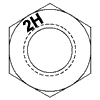 | ASTM A194 Grade 2H | Medium Carbon Steel, Quenched and Tempered | 1/4 – 4 | 850 | 175 | C24 | C38 | 1,2 |
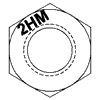 | ASTM A194 Grade 2HM | Medium Carbon Steel, Quenched and Tempered | 1/4 – 4 | 1150 | 150 | 159 | 237 | 1,2,3 |
 | ASTM A194 Grade 4 | Medium Carbon Alloy Steel, Quenched and Tempered | 1/4 – 4 | 1100 | 175 | C24 | C38 | 1,2 |
 | ASTM A194 Grade 7 | Medium Carbon Alloy Steel, Quenched and Tempered | 1/4 – 4 | 1100 | 175 | C24 | C38 | 1,2 |
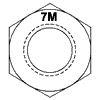 | ASTM A194 Grade 7M | Medium Carbon Alloy Steel, Quenched and Tempered | 1/4 – 4 | 1150 | 150 | 159 | 237 | 1,2,3 |
 | ASTM A194 Grade 8 | Stainless AISI 304 | 1/4 – 4 | – | 80 | 126 | 300 | 4 |
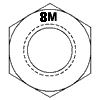 | ASTM A194 Grade 8M | Stainless AISI 316 | 1/4 – 4 | – | 80 | 126 | 300 | 4 |
OTHER ASTM GRADES FOR HEX NUTS
ASTM A563
- Scope: Provides specifications for carbon and alloy steel nuts.
- Grades: Offers a range of grades including Grade A (mild carbon steel), Grade C (medium carbon, quenched and tempered), Grade DH (carbon steel, quenched and tempered), and others, suitable for general use to high-strength applications.
ASTM F594
- Scope: Covers the requirements for stainless steel nuts used in general engineering applications.
- Grades: Classifies nuts based on alloy groups such as 304, 316, and 321, with conditions indicating the strength level (CW – cold worked, A – annealed).
ASTM F467
- Scope: This specification is for nonferrous nuts for general use, made from materials like aluminum, copper, and nickel alloys.
- Grades: Nuts are categorized by the material and its temper, e.g., Aluminum Alloy 6061-T6.
ASTM A563M (Metric)
- Scope: The metric companion to ASTM A563, covering carbon and alloy steel nuts in metric sizes.
- Grades: Similar to ASTM A563 but tailored for metric dimensions and strength classes.
ASTM F836M
- Scope: The metric version of ASTM F594, specifies stainless steel nuts in metric sizes for general engineering use.
- Grades: Classified by alloy group and condition, similar to ASTM F594 but in metric measurements.
EUROPEAN MATERIAL GRADES SPECS FOR NUTS
In Europe, the specifications for hexagonal nuts used with flanges are defined by several standards, ensuring compatibility and performance across various applications, particularly in the industrial, construction, and energy sectors. Here are some of the key European specifications:
1. EN ISO 4032
- Scope: This standard specifies the characteristics of hexagonal nuts, style 1, with threads from M1.6 up to and including M64, of product grade A for threads ≤ M16 and product grade B for threads > M16.
- Applications: These nuts are generally used for all types of flanged connections.
2. EN ISO 4033
- Scope: Similar to EN ISO 4032 but specifies the characteristics of hexagonal high nuts.
- Applications: Used where longer thread engagement is necessary or for aesthetic reasons in various assemblies, including flanged connections.
3. EN ISO 4034
- Scope: Specifies the characteristics of hexagonal nuts, style 1, with threads from M5 up to and including M39, of product grade C.
- Applications: Suitable for less critical applications where a coarse tolerance is acceptable.
4. EN ISO 4035
- Scope: This standard covers hexagon thin nuts (chamfered) with metric fine-pitch thread, product grades A and B.
- Applications: Used in applications where space constraints require a thinner nut, including some flange connections.
5. EN ISO 4036
- Scope: Specifies hexagon thin nuts (unchamfered) with metric fine-pitch thread, product grades A and B.
- Applications: Similar to EN ISO 4035, for applications needing a thin nut without a chamfer, such as certain flanged joints.
6. EN 1092-1:
While primarily focused on flanges and their joints, EN 1092-1 indirectly sets requirements for bolts and nuts used in flanged connections by specifying flange types, dimensions, and materials suitable for various pressure and temperature conditions.
Common ISO Grades for Nuts
In Europe, steel nuts and other fasteners are commonly classified according to ISO standards, which provide a uniform framework for specifications across international borders. The material grades for steel nuts under the ISO standards are designated to match specific mechanical properties, corrosion resistance, and intended use environments. Here are some common European material grades for steel nuts according to ISO:
ISO 898-2 for Carbon Steel and Alloy Steel Nuts
- Class 6: A low-strength grade used for light-duty applications where high tensile strength is not required.
- Class 8: A medium strength grade, widely used for general engineering applications.
- Class 10: A high-strength grade suitable for applications requiring good tensile strength and hardness.
- Class 12: Similar to Class 10 but with higher tensile strength and hardness for more demanding applications.
ISO 3506-2 for Stainless Steel Nuts
A1, A2, A4 Stainless Steel:
- A2 (AISI 304 equivalent): The most commonly used stainless steel grade for nuts, offering good corrosion resistance in standard environments. Suitable for both indoor and outdoor applications.
- A4 (AISI 316 equivalent): Offers enhanced corrosion resistance compared to A2, making it ideal for marine and chemical exposure environments due to the addition of molybdenum.
Tensile/Yield Strength Classification (8.8/10.9 Nuts)
The ISO 898 grading system for mechanical properties of hex nuts for flanges is a two-number system where:
- The first number multiplied by 100 gives the approximate minimum ultimate tensile strength in megapascals (MPa).
- The second number (when multiplied by the first number) gives the ratio of the yield strength to the tensile strength.
8.8 Grade Steel Nuts:
- Tensile Strength: The “8” in 8.8 indicates that the tensile strength is 800 MPa.
- Yield Strength: The “.8” indicates that the yield strength is 0.8 times the tensile strength, which calculates to approximately 640 MPa (0.8 x 800 MPa).
- Material and Coating: These are made from medium carbon steel or alloy steel and can be heat-treated. They may be coated with zinc or other protective coatings to enhance corrosion resistance.
- Applications: Grade 8.8 nuts are commonly used in automotive applications, construction, and manufacturing, where moderate levels of strength and toughness are required.
10.9 Grade Steel Nuts:
- Tensile Strength: The “10” in 10.9 indicates that the tensile strength is 1000 MPa.
- Yield Strength: The “.9” indicates that the yield strength is 0.9 times the tensile strength, which calculates to approximately 900 MPa (0.9 x 1000 MPa).
- Material and Coating: These are typically made from alloy steel and undergo a heat treatment process to achieve higher strength levels. Like the 8.8 grade, 10.9 nuts can also receive coatings for corrosion resistance.
- Applications: Grade 10.9 nuts are used in applications requiring high strength and durability, such as in heavy machinery, and structural applications, and where high loading is expected.
Key Considerations for Selection:
Application Requirements: Consider the mechanical loads, environmental conditions, and whether the application requires specific properties like corrosion resistance or prevailing torque.
Corrosion Resistance: Choose between A2 or A4 stainless steel grades based on the environmental exposure, with A4 being preferred for harsher conditions such as marine environments.
Mechanical Properties: Select the class (for carbon and alloy steel nuts) based on the required strength and application stress levels.
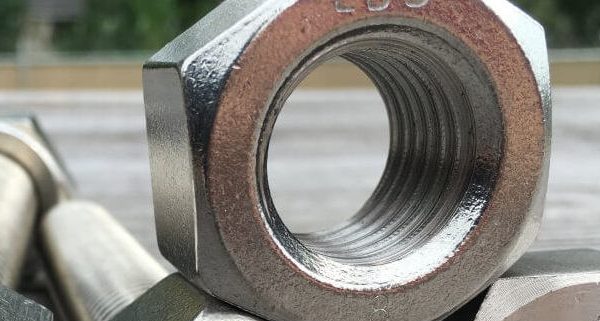

3 Responses
is there any codes (ASME, ASTM, etc.) recommend pairing of bolt and nut type (i.e B7 bolt & 2H nut)
What is difference between ASTM A 194 Gr. 7 Nut & A 194 Gr. 2H Nut
You can find an answer by looking at the chemical and mechanical tables posted on our blog. thanks.